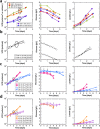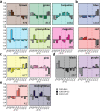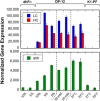Transcriptomic Insights Into Serum-Free Medium Adaptation and Temperature Reduction in Chinese Hamster Ovary Cell Cultures
- PMID: 40611689
- PMCID: PMC12232170
- DOI: 10.1002/biot.70055
Transcriptomic Insights Into Serum-Free Medium Adaptation and Temperature Reduction in Chinese Hamster Ovary Cell Cultures
Abstract
Chinese hamster ovary (CHO) cells are widely used in recombinant biopharmaceutical production; yet, yields remain low, leading to high market prices. Improving product yield and quality has heavily relied on empirical characterization with limited insight into internal molecular dynamics. RNA-seq offers a powerful alternative to understand intracellular responses to process changes through gene expression measurement. In this study, three RNA-seq datasets across three CHO cell lines and four industrially relevant treatments were integrated to characterize the global transcriptome changes, construct a weighted gene co-expression network, assess the impact on recombinant anti-interleukin 8 (anti-IL8) immunoglobulin heavy and light chain transcript abundance, and expression of glycosylation genes. Treatments included adaptation to serum-free medium, low temperature, low pH, and low glucose concentration in the medium. The findings suggest upregulation of cholesterol biosynthesis is critical for serum-free medium adaptation, and the rate-limiting enzymes in the sterol regulatory element-binding protein pathway (Insig1 and Srebf2) could be targeted to accelerate adaptation. Temperature-induced cell cycle suppression was likely mediated by p53 activation, consistent with previous reports, with the p53-targets, Zmat3 and Btg2, identified as key hub genes. Conversely, glucose and pH were observed to have negligible impacts on the transcriptome. This study uniquely identifies novel genes mediating temperature-induced cell cycle arrest, distinct glycosylation-related gene responses impacting product quality, and new stable housekeeping genes for accurate gene expression normalization in CHO cells.
Keywords: RNA‐Seq; cholesterol metabolism; co‐expression analysis; gene expression; sterol regulatory element‐binding proteins.
© 2025 The Author(s). Biotechnology Journal published by Wiley‐VCH GmbH.
Conflict of interest statement
The authors declare no conflicts of interest.
Figures





Similar articles
-
Health professionals' experience of teamwork education in acute hospital settings: a systematic review of qualitative literature.JBI Database System Rev Implement Rep. 2016 Apr;14(4):96-137. doi: 10.11124/JBISRIR-2016-1843. JBI Database System Rev Implement Rep. 2016. PMID: 27532314
-
Effect of adenosine and cordycepin on recombinant antibody production yields in two different Chinease hamster ovary cell lines.Biotechnol Prog. 2024 Jan-Feb;40(1):e3403. doi: 10.1002/btpr.3403. Epub 2023 Nov 20. Biotechnol Prog. 2024. PMID: 37985175
-
Molecular feature-based classification of retroperitoneal liposarcoma: a prospective cohort study.Elife. 2025 May 23;14:RP100887. doi: 10.7554/eLife.100887. Elife. 2025. PMID: 40407808 Free PMC article.
-
A rapid and systematic review of the clinical effectiveness and cost-effectiveness of paclitaxel, docetaxel, gemcitabine and vinorelbine in non-small-cell lung cancer.Health Technol Assess. 2001;5(32):1-195. doi: 10.3310/hta5320. Health Technol Assess. 2001. PMID: 12065068
-
Active body surface warming systems for preventing complications caused by inadvertent perioperative hypothermia in adults.Cochrane Database Syst Rev. 2016 Apr 21;4(4):CD009016. doi: 10.1002/14651858.CD009016.pub2. Cochrane Database Syst Rev. 2016. PMID: 27098439 Free PMC article.
References
-
- Dahodwala H. and Lee K. H., “The Fickle CHO: A Review of the Causes, Implications, and Potential Alleviation of the CHO Cell Line Instability Problem,” Current Opinion in Biotechnology 60 (2019): 128–137. - PubMed
-
- Lim U. M., Yap M. G. S., Lim Y. P., Goh L.‐T., and Ng S. K., “Identification of Autocrine Growth Factors Secreted by CHO Cells for Applications in Single‐Cell Cloning Media,” Journal of Proteome Research 12 (2013): 3496–3510. - PubMed
-
- Baik J. Y., Ha T. K., Kim Y. H., and Lee G. M., “Proteomic Understanding of Intracellular Responses of Recombinant Chinese Hamster Ovary Cells Adapted to Grow in Serum‐Free Suspension Culture,” Biotechnology Progress 27 (2011): 1680–1688.
-
- Rodrigues M. E., Costa A. R., Henriques M., et al., “Advances and Drawbacks of the Adaptation to Serum‐Free Culture of CHO‐K1 Cells for Monoclonal Antibody Production,” Applied Biochemistry and Biotechnology 169 (2013): 1279–1291. - PubMed
MeSH terms
Substances
Grants and funding
LinkOut - more resources
Full Text Sources
Research Materials
Miscellaneous

